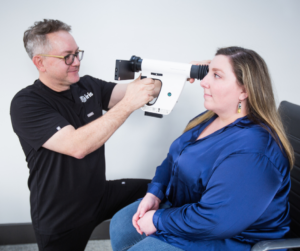The Role of Retinal Imaging Software in Population Health Management

In the U.S., 18% of adults face affordability challenges when accessing healthcare, while 21% grapple with nonfinancial barriers. As a consequence, a significant number of patients either postpone or entirely forgo necessary healthcare treatments. Such decisions can lead to deteriorating patient outcomes, undermine effective population health management, and reduce the early detection of new or worsening medical conditions. Given these challenges, it’s imperative for healthcare providers to discover innovative strategies to treat more patients and overcome the barriers to healthcare.

Introducing the IRIS solution. This retinal screening software empowers healthcare providers to connect with their patients wherever they are, quickly get them to appropriate treatments, and proactively counter the primary cause of adult blindness in the U.S.: diabetic retinopathy.
In this article, we’ll delve deeper into how IRIS’s technology is reshaping preventative healthcare, equipping healthcare providers to enhance population health management, and eliminating longstanding barriers to treatment.
But before we dive into that, let’s examine population health management in more detail.
What Is Population Health Management?
Population health management focuses on enhancing health outcomes for broad groups of people. It involves healthcare providers refining patient care methods, allocating resources equitably, and catering to the unique needs of varied patient groups. Unlike traditional treatments that address individual health issues, population health management emphasizes overall wellness for larger communities and promotes preventative measures to mitigate the risk of serious illnesses.
Traditional healthcare delivery models are evolving in response to the rising emphasis on population health management. From in-home healthcare to telehealth initiatives, providers are adopting population health management strategies that prioritize meeting patients where they are to overcome treatment obstacles and promote a greater number of preventative health screenings.
Population Health Management Strategies
In-Home Healthcare Services
The trend towards in-home healthcare is accelerating. By 2025, it’s projected that as much as $265 billion in care services might transition from traditional settings to home environments for Medicare FFS and MA beneficiaries, all without compromising the quality or accessibility of patient care.

Furthermore, a 2021 study revealed that at-home treatments can enhance patient satisfaction and overall quality of life. In certain scenarios, it can even lead to a reduction in healthcare expenses.
Though in-person visits remain the primary mode of treatment, healthcare providers are recognizing their limitations. Advanced technology and the advent of portable medical devices are paving the way for a shift. Instead of patients traveling to seek treatment, the trend is moving towards healthcare providers reaching patients in their own environments.
Telehealth and Telemedicine
Since the onset of the COVID-19 pandemic, telehealth and telemedicine have played pivotal roles in enhancing population health management. These services have opened doors for physicians and patients to connect beyond traditional in-person encounters.
This has particularly benefited those in remote locations, ensuring timely medical interventions, which, in turn, halts the advancement of potentially deteriorating conditions. Additionally, both patients and providers have seen cost reductions.

When it comes to closing patient care gaps, telehealth and telemedicine stand out as primary facilitators. One reason patients often avoid seeking medical treatment is the inconvenience related to transportation. However, with the integration of telehealth and telemedicine in population health management strategies, these barriers are minimized.
Patients now have the convenience of consultations or preliminary screenings via phone or computer, enabling them to gauge the urgency of their conditions. This preliminary step aids patients in determining the necessity of future in-person treatments.
Preventative Screenings
By increasing the amount of preventative screenings administered to patients, chronic or worsening diseases can be caught earlier on in their development. However, only 8% of people in the United States undergo preventative screenings regularly. This can be for a multitude of reasons, but many don’t because of cost, lack of convenience, proximity, and even low awareness about getting preventative screenings.
To increase the number of preventative screenings that improve population health management, there must be advancements in technology that circumvent the barriers stated previously. Luckily, that’s what the IRIS solution is for.

By increasing the number of preventative screenings administered to patients, it’s possible to detect chronic or progressive diseases at earlier stages. Yet, in the United States, only 8% of the population consistently undergoes these screenings. Several factors contribute to this shortfall, including cost, inconvenience, distance to healthcare facilities, and a general lack of awareness about the importance of regular screenings.
To increase the number of preventative screenings and improve population health management, it’s crucial to integrate technological solutions that address these barriers.
How Does the IRIS Solution Impact Population Health Management
To improve population health management, one area that cannot be overlooked is the impact of diabetic retinopathy on patient populations.
Around 10 million Americans are diagnosed with diabetic retinopathy. This severe eye condition constitutes 4.8% of the 37 million global blindness incidents, emerging as the predominant cause of blindness in adults aged 20 to 74. The silver lining: it’s preventable.
IRIS stands committed to curbing preventable adult blindness. Our all-inclusive retinal imaging software can be integrated into any healthcare provider’s workflow, enabling a more direct reach to diabetic patients. Not only does our platform enhance fundus photography, but it also facilitates remote examinations by physicians from across the nation. Upon assessment, experts from the IRIS Reading Center can input results into the patient’s EHR, helping streamline the referral process to the right specialists.
The IRIS solution’s merit lies in its ability to bridge patient care gaps. Our imaging software’s versatility, plus its compatibility with handheld and stationary cameras, offers flexibility. The common roadblocks to treatment such as transportation constraints and scheduling issues can be circumvented, and healthcare professionals get more efficient strategies to care for their patients.
By offering a patient-centric solution, the IRIS solution ensures more individuals undergo screenings for serious conditions like diabetic retinopathy, meaning earlier detection, better treatment, and narrower patient care gaps.
Closing Patient Care Gaps and Managing Population Health With IRIS
If you’re a healthcare provider looking for more ways to close patient care gaps and improve population health management, it’s time to get started with the IRIS solution. We work with the best-trained physicians from across the country to give accurate results for diabetic retinopathy in a timely manner, striving to end preventable blindness. Choosing a solution that is quick, accurate, and multi-faceted can help you do the same.
To get started, contact us. You’ll talk with one of our experts who will guide you through a free demo of our system. Ending blindness from diabetic retinopathy starts with IRIS.
Frequently Asked Questions
What Is an Example of Population Health Management?
An example of population health management could be a program for teaching people with type I or type II diabetes about the effects and likelihood of developing diabetic retinopathy and yearly screenings that should be taken to prevent it.
What Are the Four Pillars of Population Health Management?
According to the Jefferson School of Population Health at Thomas Jefferson University, the four pillars of population health management are:
- Chronic care management
- Quality and safety
- Public Health
- Health Policy
What Are the Three Key Elements for Successful Population Health Management?
According to the American Hospital Association, the three key elements for successful population health management are
- Information-powered clinical decision-making
- A clinical workforce that’s primary care-led
- Community integration and patient engagement
SM# 157, Rev A
Get started with IRIS today.
Want to know if IRIS is right for you? Schedule a one-on-one consultation with our team. We’re here to help.